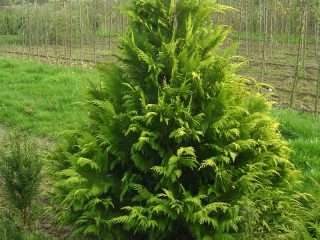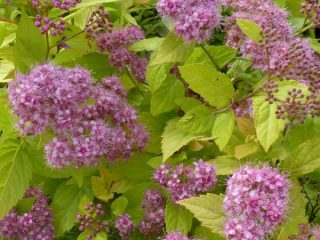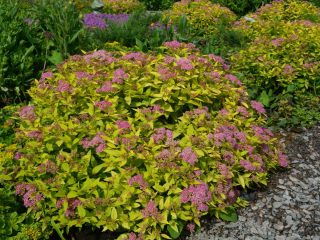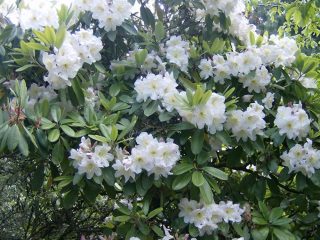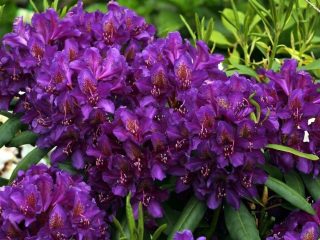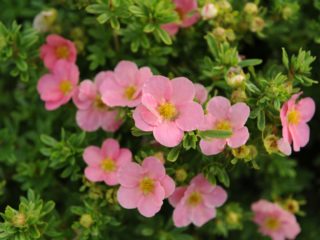Content
Purple sapling is one of the many ornamental garden herbaceous shrubs. It is well known to landscape designers and is often used for landscaping and decorating park areas and local areas. Experts especially note that this perennial practically does not get sick and is not affected by pests, is easy to care for and at the same time has a very attractive appearance.
Description
Purple sapling (lat. Eupatorium purpureum) is a perennial herbaceous shrub. It belongs to the Asteraceae, or Asteraceae, family. Found in the wild in Europe, Asia, and America. “Poskonnik” received its modern name for its resemblance to hemp, which in Rus' was previously called “poskon”.

Purple sapling - a modest handsome man
The main parameters of purple sapling are presented in the table:
Parameter | Meaning |
Russian names-synonyms | Hemp, turnip, horse's mane, sedach, shaposhnik |
Plant type | Herbaceous perennial shrub |
General form | Dense, heavily leafy, medium-spreading bush up to 2 m high and up to 1 m wide, over time can form continuous thickets |
Escapes | Erect, non-branching, powerful, red-violet |
Leaves | Opposite or whorled, elongated spear-shaped, slightly boat-curved, bright green with reddish-purple veins, edge of the plate slightly serrated, petiole short |
Root system | Well developed rhizome |
Flowers | Pink-lilac, small, with a tubular corolla, collected in inflorescences-baskets, forming voluminous caps up to 30 cm in diameter at the ends of the shoots |
Fruit | Small, dark, rough, located in seed pods |
Flowering period
Purple sapling blooms in mid-summer. At this time, the plant emits a subtle, pleasant aroma that attracts many butterflies and other insects. Flowering lasts about 7 weeks and usually ends in September, although individual specimens may continue to bloom until the first frost.
Growing from seeds
In the wild, purple sapling reproduces by self-sowing, which is why the plant eventually forms dense thickets. The seed method can also be used for growing seedlings and then planting them on the site. However, if you plant sapling seeds directly in open ground, the grown plants will bloom only in the 3rd year. Therefore, it is recommended to use the seedling method.
Seed preparation
Before sowing planting material, it must be stratified for 1 month. It is better to do this in February-March.Purple sapling seeds are mixed with sand and placed in the refrigerator for this period, where they are stored in a vegetable tray at a temperature of about + 2 °C.
When to plant
At the end of stratification, the seeds of purple sapling are sown in containers filled with special soil. The optimal time for this is the last ten days of March. By this time, you need to prepare wide and shallow containers for growing seedlings, and also stock up on soil, purchasing it in a store or mixing sand, peat and turf soil in equal proportions yourself.
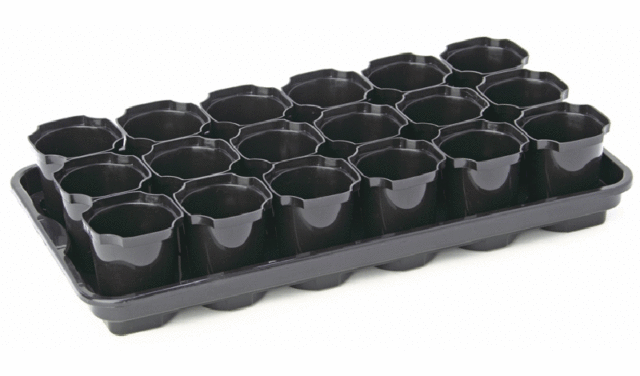
It is very convenient to use special cups or cassettes for growing seedlings
How to grow seedlings
Stratified seeds of purple sapling are kept for 1 day in a weak solution of potassium permanganate, and then planted in containers filled with soil without being buried. The planting material is evenly distributed over the surface, lightly pressed down or sprinkled with a thin layer of soil, and then moistened with water from a spray bottle. The container is covered with glass or film and then placed in a warm, dark place.
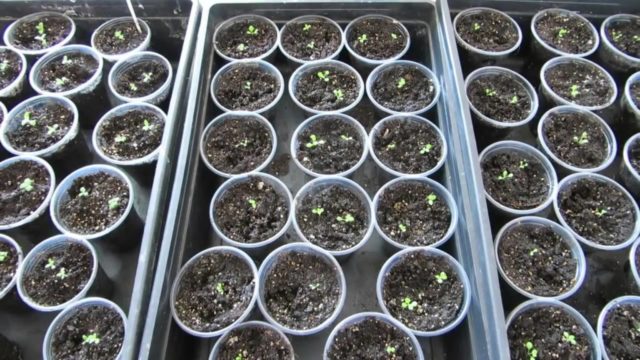
It takes 2 to 3 weeks for purpurea seeds to germinate
Purple sapling seeds germinate in 2-3 weeks. After the first shoots appear, the cover should be removed and the container moved to a well-lit place. After 2 pairs of permanent leaves appear, the seedlings are picked into separate pots.It will remain there until the end of May; it is at this time that it is transplanted into open ground. Approximately 10-14 days before this, the containers begin to be exposed to air, and the holding time is increased each time. This is how plants are hardened.
Planting in open ground
Purple sapling is undemanding to growing conditions. The procedure for planting it is simple, as is its subsequent care.
How to choose a place
Purple sapling has no special preferences, it does not place high demands on the site and grows well both in the sun and in partial shade. The soil is preferably fertile and loose; this plant does not feel comfortable on clay and sand. Acidity should be close to neutral.
How to prepare the soil
Before planting young seedlings of the purple sapling, the soil on the site should be dug up, cleared of debris and old grass, and at the same time add compost (3-5 kg per 1 sq. m). Planting holes are prepared based on the size of the seedling's root system. When planting in groups, the intervals between neighboring plants should be at least 0.6 m. The seedlings are removed from the cup along with a lump of earth on the roots and carefully placed in a hole, sprinkled with earth and compacted. After this, the young seedling must be watered abundantly.
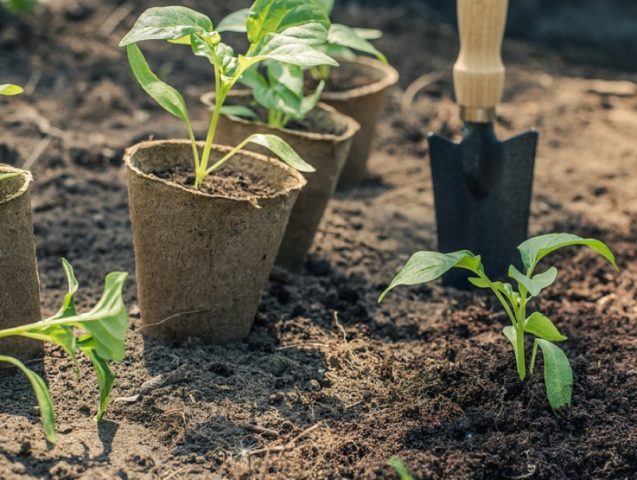
Peat cups eliminate the need to remove the plant before planting
Watering
Purple sapling loves moist soil, but excess water is harmful to it. Excessive moisture can lead to rotting of the roots and death of the plant, so watering is required, although regular, but moderate. Newly planted seedlings, as well as separated parts of rhizomes that are in the process of rooting, need additional watering. At such times, you need to be especially careful to ensure that the soil does not dry out.
Feeding
Frequent regular fertilizing of purple saplings is not required. In early spring, nitrogen fertilizers are applied, stimulating the growth of shoots, and during the period of budding and flowering, you can use any complexes for flowering shrubs, for example, Kemira-Universal.
Do I need to tie it up?
The stems of the purple sapling are strong and rigid; they can easily withstand the weight of a large, cap-shaped inflorescence. The bushes themselves are also quite dense and resist the wind well. Therefore, there is no need to tie them up.
Features of care during flowering
There are no special care requirements during the flowering period of the purple sapling. During this period, you need to ensure that the soil in the root zone does not dry out, and also remove weeds to maintain the decorative appearance of the bush. It is better to postpone all other procedures until flowering is over.
Reproduction methods
Purple sapling can be propagated both by seeds and vegetatively. It is preferable to use the second method, since in this case all varietal characteristics of the plant are guaranteed to be preserved. In addition, when using vegetative methods, a full-fledged flowering bush can be obtained much earlier.
Dividing the bush
This propagation method is suitable for purple sapling bushes that are at least 5 years old. Its essence is as follows.
- In early spring or autumn, all shoots of the bush are cut off at a height of 0.2-0.3 m.
- The rhizome is dug out of the ground.
- Using a sharp bayonet shovel or an ax, the rhizomes are divided into parts containing several shoots with their own lobe.
- The sections are treated with a solution of potassium permanganate or brilliant green.
- The delenki are immediately planted in pre-prepared pits.

Each division must have at least 3 growth points
Young shoots
This method is similar to the previous one. For propagation, young shoots of purple sapling with a height of at least 5 cm are used, which are cut off along with the root. For growing, they are placed in special containers or boxes filled with soil for seedlings. The plants are kept in such comfortable conditions for about a month, providing them with good care and regular moderate watering. Then the strengthened seedlings of purple sapling are transplanted to a permanent place in open ground.
Cuttings
The sapling can be propagated by green cuttings, which are harvested in June. They are cut from annual shoots, the length of each should be at least 10-15 cm. Green cuttings are rooted in containers filled with a mixture of peat and sand. Planting is carried out obliquely, the depth should be about 5 cm.

Rooted cuttings should be covered with a glass jar or cut plastic bottle
A film cover must be mounted on top, or each cutting must be covered with a cut plastic bottle or glass jar.It will take about 1 month to form its own root system, after which the seedlings are transferred to a permanent place.
Trimming
Pruning purple sapling bushes can be done in order to increase the decorativeness of the bush as a whole or to get rid of improperly growing, weakened or diseased shoots. You can also remove dried inflorescences, this will extend the flowering period of the entire bush as a whole.
Wintering
Before wintering, the sill bush is cut off completely, leaving stumps 10-15 cm high. Young first-year plants can be covered with spruce branches. Older bushes, as a rule, do not suffer from cold weather and do not need any shelter.
Diseases and pests
Purple sapling has excellent immunity to diseases and pests. It is a poisonous plant, so neither insects nor other animals touch it. Viral diseases may occasionally cause leaf curl; in this case, the affected areas of the bush should be cut out and burned.
Photo of a window sill in landscape design
A lush purple sapling bush can be a good accent in a garden composition. In addition to individual plantings, you can also use group ones, for example, to create a hedge or a color background for smaller plants.
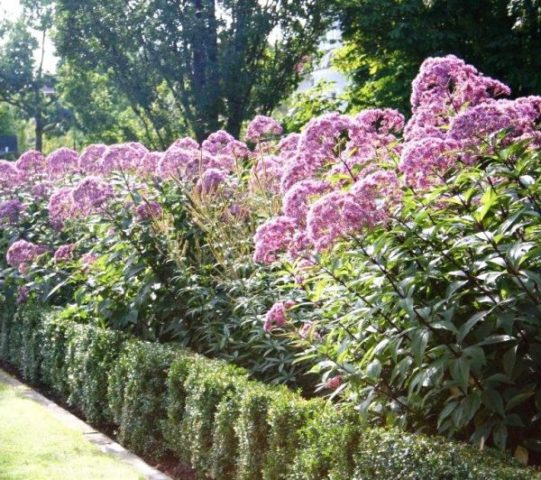
A two-level hedge provides excellent protection from the wind.

Purple sapling looks great as part of a mixborder
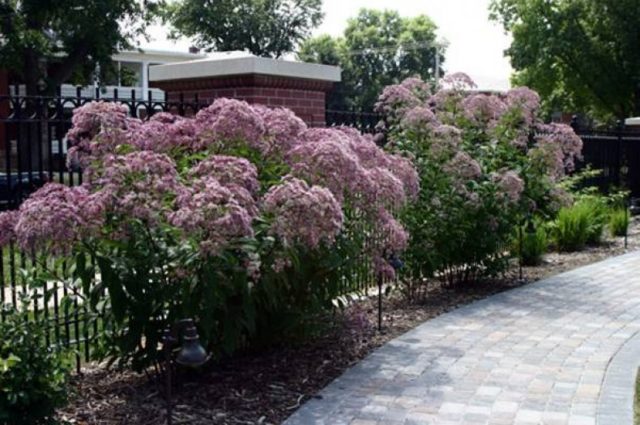
Purple sapling bushes can decorate a wrought-iron fence

Sill bushes harmoniously combine with water bodies
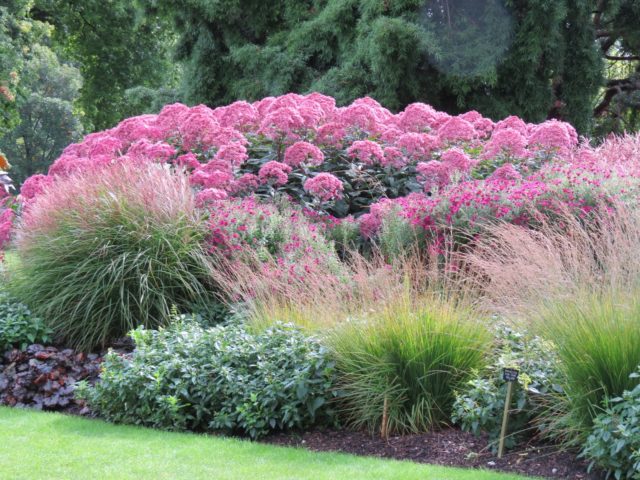
In combined flower beds, the window sill is planted in the background; it serves as a backdrop for other, smaller plants
Bouquets in floristry
Purple sapling flower caps look good in bouquets. They are often placed separately in a vase, but the plant remains decorative for a long time and remains attractive even after drying. When combined with more expressive colors, the window sill can be used as a background.
Use in folk medicine
Purple sapling is included in the list of medicinal plants in Russia. It has long been used in folk medicine as an anti-inflammatory, expectorant, and diuretic. Currently, its medicinal value has been greatly lost, since much more effective drugs have been synthesized. It should also be taken into account that all parts of the purple sapling contain toxic substances - alkaloids, therefore any homemade products based on this plant should be used with caution and only after consulting a doctor.
Conclusion
Purple sapling is not often found in gardens and personal plots. At the same time, this is one of the most unpretentious plants that can decorate even remote corners of the garden. The agricultural technology for growing purple sapling is extremely simple, so we can safely recommend it for cultivation even to the most inexperienced gardeners.
